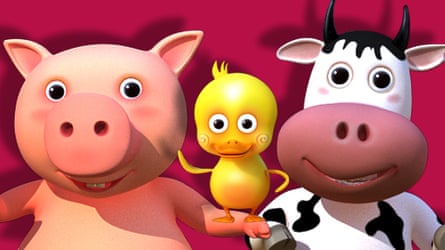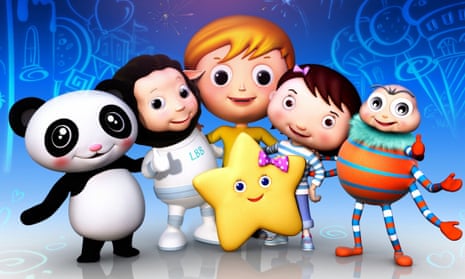“The other day, I got an alert saying our Wheels on the Bus compilation was 63rd on YouTube’s all-time chart. I had a look, and number 64 was the theme tune from Frozen.”
Derek Holder, who runs the Little Baby Bum YouTube channel with his wife, sounds both amused and baffled as he tells the Guardian about its startling growth. But he’s absolutely right.
Disney’s official video for Let It Go has been watched more than 430m times on YouTube since its release in December 2013, but Wheels On The Bus trumps it with nearly 440m views since its release in August 2014.
Impressive work for the channel that the Holders founded in 2011 on a hunch that lots of parents were looking for nursery-rhyme videos on YouTube, and run from the UK. Their hunch, it’s fair to say, proved correct.
In 2014, Little Baby Bum was the 36th biggest channel on YouTube with more than 1bn views, but that masks its rocketing growth towards the end of the year: 140m views in September, 189m in October, 221m in November, and 319m in December.
By January 2015, Little Baby Bum was the fifth most popular channel on YouTube, and part of a wider surge of viewing for children’s videos on the service. It’s about to pass 2bn lifetime views.
“This wasn’t by design, it was by luck – we were in the right place at the right time,” says Holder. “It’s been mindblowing. Staggering. We pinch ourselves every day.”
If you don’t have a toddler, Little Baby Bum will have flown well below your radar. The channel houses a collection of animated songs, including nursery rhymes and original songs about numbers, letters and, er, potties.
The channel was born in 2011 when Holder was sitting in front of a computer with the couple’s youngest child – nicknamed Little Baby Bum since her earliest days – looking for nursery rhyme videos.
“I was a bit stunned by the lack of decent-quality stuff. There were hilarious videos: one was Baa Baa Black Sheep and it was actually a goat. In others the sheep was grey or the lyrics were generally wrong,” he says.
“The animation often looked like the animation I grew up on in the 1970s and 80s. I looked at TV channels like CBeebies and the good quality there, then looked at YouTube, and I thought ‘these don’t really tally’. Yet those videos were getting 10 or 20m views.”
Derek’s background was in IT and telecoms – including search engine optimisation (SEO) – and he had “pottered around” with music in his spare time, while his wife ran a design agency.
“We thought why not combine our efforts and have a go? It can’t be worse than what’s on there already,” says Holder.
“There were a lot of what I’d call cynical videos in the under-fives arena made purely for money with no heart or love in it.”

They made one video, a 30-second version of Twinkle Twinkle Little Star, which was watched about 15,000 times in the first month after its release in August 2011. A second, Baa Baa Black Sheep, followed in December that year.
The channel grew steadily, to the point where, 18 months in, the couple were able to start working with a professional musician in the US on the songs.
Derek’s SEO experience was undoubtedly one factor in Little Baby Bum’s ability to attract viewers, but he points to his wife as the channel’s secret weapon.
“She’s what sets us apart. She is from a design background, and was born and bred in Hong Kong. She isn’t as ingrained in a lot of these nursery rhymes as I am: she’s coming in fresh, and with a design point of view,” he says.
“She comes out with all these lovely ideas: Baa Baa flying a spaceship for example. We made a point of keeping the lyrics and music side as traditional as we could, but on the visuals we could go as crazy as we wanted to.”
Why did Little Baby Bum grow so fast in the latter half of 2014? Holder says that the genesis was a gathering at YouTube’s headquarters in the spring of that year, and a discussion about the popularity of compilation videos on the service.
Little Baby Bum tried a 51-minute compilation of ABC songs, which did fairly well, but it was the 54-minute Wheels On The Bus compilation that took off.
“It’s gone absolutely potty: for whatever reason, it’s caught the imagination. I can’t quite say why. Long-form compilations are a sweet spot in our genre though,” says Holder.
“From a parental point of view, we know what a pain it is to keep pressing the ‘play’ button. If you’ve got one video that’s 50 or 60 minutes long, you can just press play and leave your child to watch it while you get something done.”
However, he says that feedback from parents suggests Little Baby Bum is far more than just a digital distraction for their children. He cites one recent letter from a parent whose 23 month-old son has autism, thanking the channel for the role it has played in his development of communication skills.
“She said that he was ABCing and 123ing after watching the videos. It was a beautiful thing to receive. I don’t know if our videos had really done that or if it was a coincidence, but she thought it had,” says Holder.
“We try to reply to all emails from parents. It’s a personal thing. If somebody’s taken the bother to email – they’ve gone off YouTube to our website, found the contact page and written an email – they deserve to get something back.”
Children’s videos are huge on YouTube, with six of its top 10 channels in January aimed at kids: toy-unboxing channels Funtoys Collector and Blu Toys; Minecraft gamer Stampy; Little Baby Bum; and two Russian animation channels, Masha and the Bear and GetMovies.
YouTube is responding to the trend, having recently launched its YouTube Kids app in the US and revealed that family content is its fastest-growing category.
“It took them by surprise, but I’ve noticed by the number of personnel they have coming into the European offices and working there, they’re taking it much more seriously,” says Holder.
“They’ve got the Kids app, and a lot more development work going on around that. Google as a company are taking the under-13 mass as a really important next part of their journey.”
So what next for Little Baby Bum? The Holders are talking to YouTube about possibly launching a second channel, but that will be “way, way down the line” if it happens.

The emphasis is more on localisation in the short term, launching new versions of Little Baby Bum for Latin America (in Portuguese for Brazil) and Russia. Holder also says the channel is stepping up its production.
“We currently make one video a week, but from around May we’re going to be releasing two a week. It doesn’t sound like a lot, but it’s like when you go from one child to two children – it’s not just doubling your effort, it’s much more than that,” he says.
Established TV companies and other children’s brands are also in the picture, although Holder can’t yet talk about any specific deals due to non-disclosure agreements beyond saying that “some very interesting brands are talking about us at board level”.
Little Baby Bum is also exploring the potential of getting its content onto connected televisions. It has already signed a deal with a company called VOD365 to be part of its Ketchup TV subscription service alongside brands like Bob the Builder, Thomas and Friends and Pingu.
Holder says that the traditional children’s television industry is finally waking up to the brands being built on YouTube.
“Some of them are still half asleep, but it’s changing fast,” he says. “I think they should embrace it: YouTube is a lot of eyes and ears on your product, and it’s brilliant exposure.”
In the meantime, Little Baby Bum is proceeding cautiously, feeling out potential partners from the traditional media world, while investing in the quality and quantity of its videos to make sure the wheels don’t come off this particular bus.

Comments (…)
Sign in or create your Guardian account to join the discussion